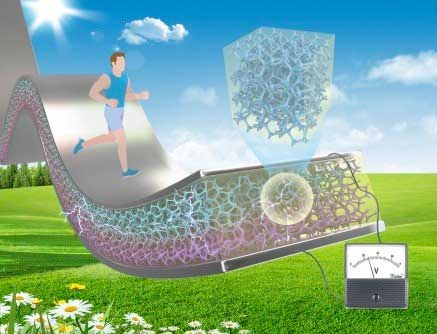| Posted: May 17, 2018 |
Flexible, highly efficient multimodal energy harvesting
(Nanowerk News) A piezoelectric ceramic foam supported by a flexible polymer support provides a 10-fold increase in the ability to harvest mechanical and thermal energy over standard piezo composites, according to Penn State researchers (Energy and Environmental Science, "Flexible three-dimensional interconnected piezoelectric ceramic foam based composites for highly efficient concurrent mechanical and thermal energy harvesting").
|
 |
| A flexible ceramic foam for energy harvesting. (Image: Wang Lab/Penn State)
|
|
In the search for ways to harvest small amounts of energy to run mobile electronic devices or sensors for health monitoring, researchers typically add hard ceramic nanoparticles or nanowires to a soft, flexible polymer support. The polymer provides the flexibility, while the piezo nanoparticles convert the mechanical energy into electrical voltage.
|
|
But these materials are relatively inefficient, because upon mechanical loading the mechanical energy is largely absorbed by the bulk of the polymer, with a very small fraction being transferred to the piezo nanoparticles. While adding more ceramic would increase the energy efficiency, it comes with the tradeoff of less flexibility.
|
|
“The hard ceramics in the soft polymer is like stones in water. You can slap the surface of the water, but little force is transferred to the stones,” said Qing Wang, professor of materials science and engineering, Penn State. “We call that strain-transfer capability.”
|
|
Almost three decades ago, the late Penn State materials scientist Bob Newnham came up with the concept that the connectivity of the piezo filler determined the efficiency of the piezoelectric effect. A three-dimensional material would be more efficient than what he classified as 0D nanoparticles, 1D nanowires or 2D films, because the mechanical energy would be transported directly through the 3D material instead of dissipating into the polymer matrix.
|
|
“Bob Newnham was a legend in the field of piezoelectrics,” said Wang, “So everybody in the ceramic community knew of his approach, but how to achieve that 3D structure with a well-defined microstructure remained a mystery.”
|
|
The secret ingredient to solve the mystery turned out to be a cheap polyurethane foam dusting sheet that can be purchased at any home improvement store. The small uniform protrusions on the sheet act as a template for forming the microstructure of the piezoelectric ceramic. The researchers applied the ceramic to the polyurethane sheet in the form of suspended nanoparticles in solution. When the template and solution are heated to a high enough temperature, the sheet burns out and the solution crystalizes into a solid 3D microform foam with uniform holes. They then fill the holes in the ceramic foam with polymer.
|
|
“We see that this 3D composite has a much higher energy output under different modes,” said Wang. “We can stretch it, bend it, press it. And at the same time, it can be used as a pyroelectric energy harvester if there is a temperature gradient of at least a few degrees.”
|
|
The other corresponding author on the new paper in the high-impact journal Energy and Environmental Science is Sulin Zhang, professor of engineering science and mechanics, Penn State. Zhang and his students were responsible for extensive computational work simulating the piezoelectric performance of the 3D composite.
|
|
Said Zhang, “We were able to show theoretically that the piezoelectric performance of nanoparticle/nanowire composites is critically limited by the large disparity in stiffness of the polymer matrix and piezoceramics, but the 3D composite foam is not limited by stiffness. This is the fundamental difference between these composite materials, which speaks to the innovation of this new 3D composite. Our extensive simulations further demonstrate this idea.”
|
|
Currently, Wang and collaborators are working with lead-free and more environmentally friendly alternatives to the current lead-zirconium-titanate (PZT) ceramic.
|
|
“This is a very general method,” said Wang. “This is to demonstrate the concept, based on Bob Newnham’s work. It is good to continue the work of a Penn State legend and to advance this field.”
|

